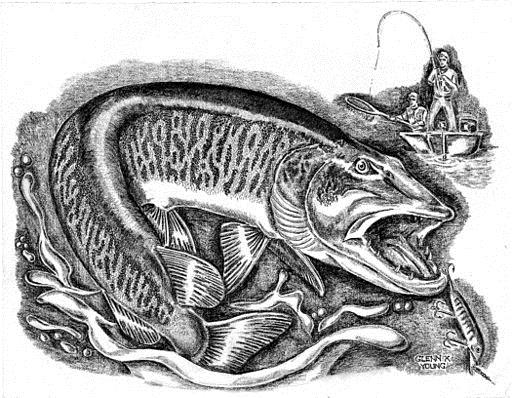 Ancient folklore describes the muskie as a beast among fish, an eel-like creature that slithers along the ocean floor with an aggressive nature that urges fisherman to use caution with this fish. The muskie or muskellunge (Esox masquinongy) has an elongated head and body that makes it an excellent ambush predator.
Ancient folklore describes the muskie as a beast among fish, an eel-like creature that slithers along the ocean floor with an aggressive nature that urges fisherman to use caution with this fish. The muskie or muskellunge (Esox masquinongy) has an elongated head and body that makes it an excellent ambush predator.
It hides among seaweed and waits for prey, and its sharp teeth are pefect for pointing holes in anything unfortunate enough to cross its path. An adult muskie is an apex predator; only humans pose a significant threat. Its weight ranges from 30 to 60 pounds or even up to 110 pounds, according to a 1908 fisherman’s myth. It can be found in northern freshwater waterways such as the Great Lakes.
It’s commonly found in large rivers in Michigan, Wisconsin, Minnesota and northern Canada. On July 5, Jim Hack, a financial advisor in Barrington, reeled in a whopping 54-inch muskie from a lake in Lake County, Illinois. He brought it to the Salmon Stop in Waukegan, where it was certified. It weighed 35 pounds, 10 ounces with a length of 54 inches and girth of 22.5 inches. This fish has now gone on record to be the largest muskie caught in Illinois in 2006 but still short of a 2002 muskie caught by Matt Carmean that weighed in at 38 pounds, 8 ounces with a length of 50 ¾ inches. Carmean was fishing for walleye below the Lake Shelbyville Dam.
Hack battled the nearly 36-pound fish for twelve minutes. The force of an unbending, huge fish dwarfed his usual 2 - 3 minute catching time. Hack supports catch and release practices which allows the sport of fishing to be observed without the killing of fish, typically. He had a desire to save the fish but it did not resuscitate after removal of the hook.
Catches like of this sort were once rare in Illinois but the changing ecosystem has created frequent reporting of abnormally large fish. Hacks did not share the lake location, so muskie fanatics will have to go searching for this charmed Illinois fishing hole .



